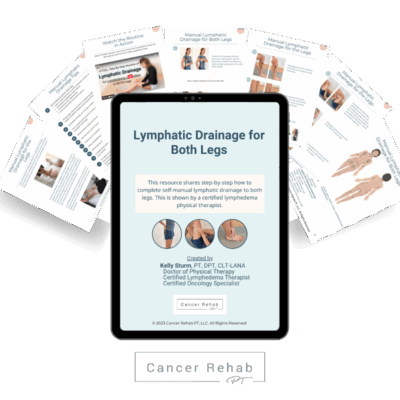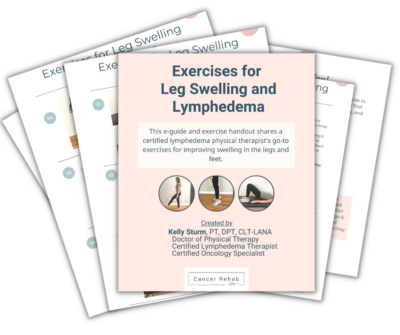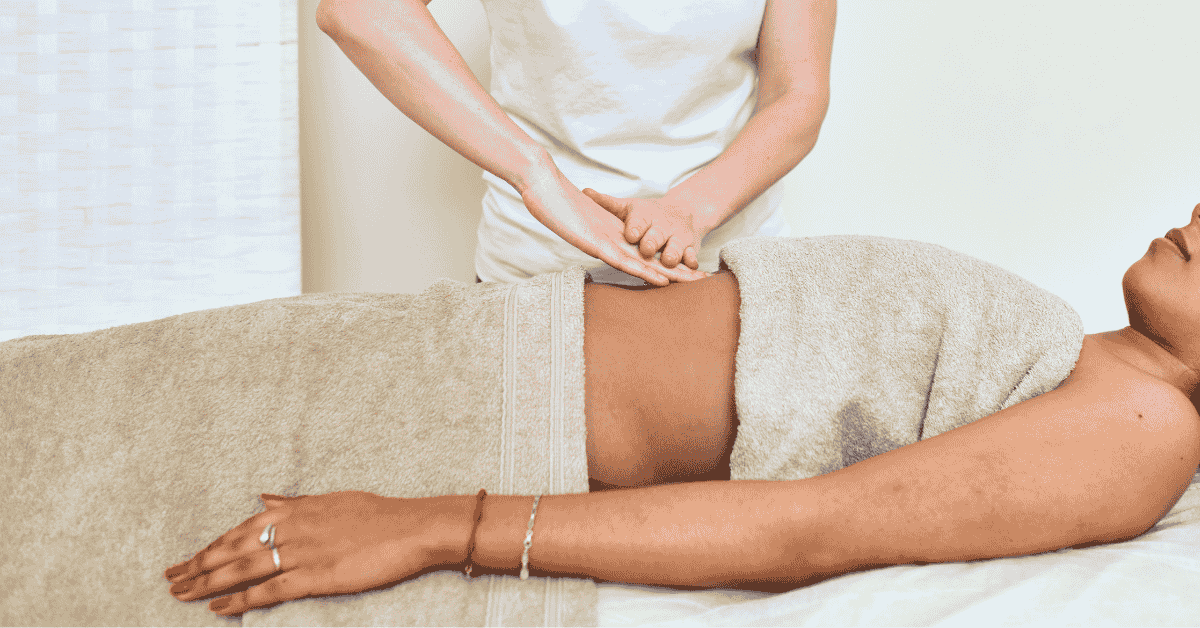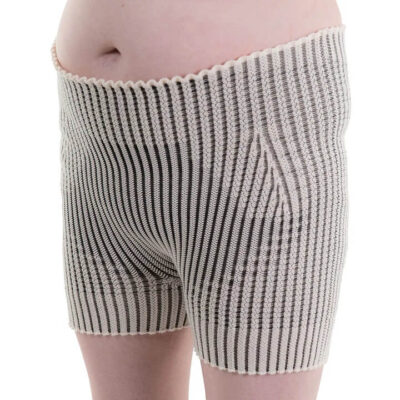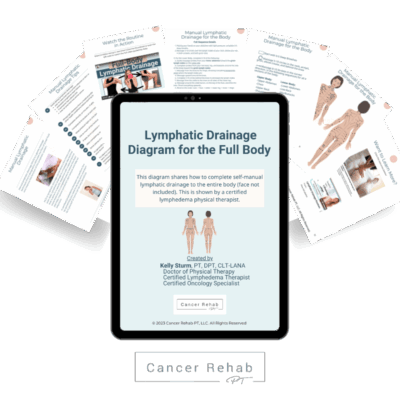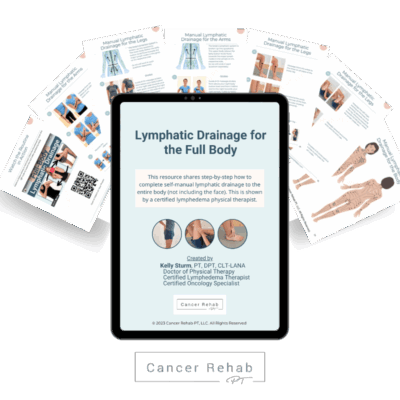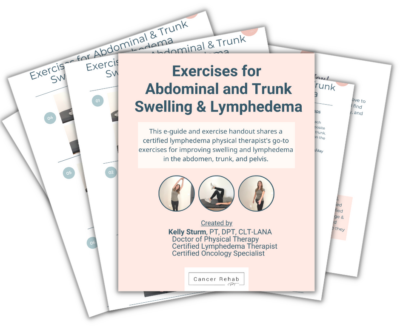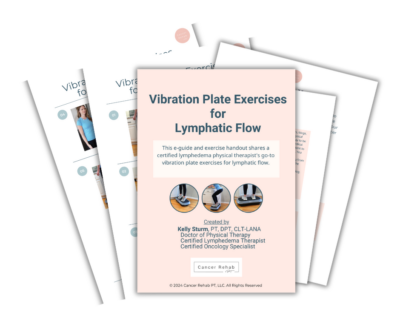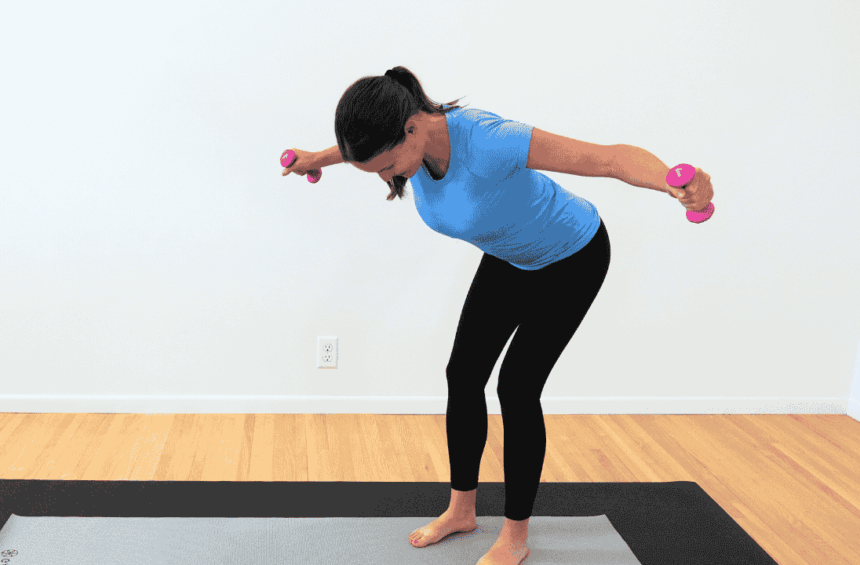The different stages of swelling after tummy tuck are a normal part of recovery from abdominoplasty surgery. It’s unavoidable as your body heals, but post-tummy tuck swelling can feel uncomfortable and frustrating.
Luckily, there are a couple of ways to help your body reduce swelling a little faster.
Here are my best tips as a lymphatic specialist (PT, DPT, CLT-LANA) on how to make the swelling go down after a tummy tuck surgery.
What Is Post-Tummy Tuck Swelling?
Swelling after a tummy tuck procedure is a normal part of recovery.
During the plastic surgery, your doctor removes excess skin and fat and then tightens the abdominal muscles. Fluid accumulates in your abdomen as a response to this.
The surgical trauma triggers your body’s natural inflammatory response, which brings extra fluid and white blood cells to the area to promote healing.
Your lymphatic system, which drains excess fluid from your tissues, is also disrupted during surgery. Surgery can temporarily damage lymphatic vessels, so your body can’t drain fluid as well as it normally does.
As a result, swelling occurs, and your body doesn’t drain it as effectively as it used to.
According to the American Society of Plastic Surgeons, a tummy tuck is one of the top five cosmetic procedures for both men and women.
The overall complication rate sits at just 2.1%, and swelling is one of the most common and expected parts of tummy tuck recovery.
In most cases, it’s nothing to worry about, but there’s no doubt that this part of your body’s natural healing process can be very uncomfortable.
5 Stages of Swelling After Tummy Tuck
Most patients follow this tummy tuck swelling timeline, although it can look a little different depending on the person and the scope of your surgery.
1. Week 1
The first week has the most significant swelling, and it can feel discouraging. That’s completely normal. Your abdomen will feel tight, heavy, and larger than you expected.
This happens because your body is sending extra fluid to your abdomen to help it heal. It’s totally normal, even though it doesn’t feel great.
The swelling often extends beyond your stomach into your pubic area, hips, and thighs, and bruising is common. Your surgeon will most likely recommend bed rest at this stage for a smooth recovery.
2. Weeks 2-4
Swelling starts to improve, but you may still deal with a lot of fluid retention and puffiness. However, you’ll start seeing more definition as the inflammation calms down.
You might feel better in the morning, and then notice more swelling by the evening, especially if you spend some time on your feet. This happens because your lymphatic system is still healing and can’t drain fluid as well as usual yet.
3. Months 2-3
You’ll see a lot of improvement during this stage. Most of the inflammatory swelling resolves, and your abdomen looks much closer to what it’s going to look like long-term.
Instead of general puffiness, you might see it concentrated above your incision line or in the areas where your surgeon removed more skin or tissue.
4. Months 4-6
At this point in the recovery period, you usually only have minor swelling, typically later in the day or after an activity. Most people can get back to their normal routine at this point, though you’ll still want to avoid heavy lifting and really intense workouts for a while longer.
5. Months 6-12
You may still notice some swelling here or there, but by the one-year mark, most people reach their final tummy tuck result.
Regular physical activity (such as rebounder workouts) and a healthy diet can help your lymphatic system manage swelling more effectively after surgery, and in general.
Red Flags to Watch Out for After Tummy Tuck Surgery
Some swelling is completely normal after surgery. But sometimes swelling can be a sign that something’s wrong and needs immediate medical attention.
Contact your plastic surgeon right away if you experience:
- Sudden increase in swelling
- Swelling that’s warm and red
- Fever
- Foul-smelling drainage
- Severe pain, especially if it gets worse
- Difficulty breathing or chest pain
These symptoms can be a sign of blood clots, a dangerous infection like cellulitis, or other complications. These are rare after a tummy tuck, but it’s important to know what to watch for just in case.
Learn more about when you should worry about swelling after surgery.
How to Reduce Swelling After Tummy Tuck
Listen to Your Doctor
Your surgeon will give you personalized instructions for recovery. It’s important to follow these guidelines to reduce swelling and avoid complications. Most of the time, these instructions include:
- Avoid strenuous exercise and heavy lifting for 2-3 months
- Sleep with your upper body elevated for the first few weeks
- Avoid smoking and alcohol
- Take prescribed pain medications as directed
- Gradually increase walking and light exercise
- Keep the abdominal area clean
Wear Compression Garments
Compression garments are tight, elastic garments that put gentle and consistent pressure to your abdomen. Your surgeon will likely have you start wearing one right after the surgery.
They help with swelling by keeping fluid from building up in your belly.
The pressure helps move fluid out instead of letting it sit in one spot, and it can also help minimize scar tissue formation.
Most surgeons recommend wearing your compression garment 24/7 for the first few weeks, and then gradually reducing your wear time. You may get recommendations from your surgeon on which garments to wear, but here are some of my favorite ones, too:
Try Lymphatic Massage
Lymphatic massage (also called manual lymphatic drainage) uses gentle and rhythmic strokes to help move lymph fluid through your body. When you do it right, it can help reduce swelling, speed up recovery, and help you feel more comfortable after surgery.
You can see a certified lymphedema therapist who specializes in post-op care, or you can learn to do lymphatic massage at home once your incisions have healed.
Here are a few resources to help you get started with the proper technique:
There are many benefits of lymphatic drainage massage, and you can do it for your entire body, not just your abdomen. It can be a great form of self-care, too.
Stay Hydrated
When you’re dehydrated, your body holds onto fluid because it thinks there’s not enough, which makes swelling worse. Try to drink at least 8 glasses of water a day, and more if you live in a hot climate.
In the early weeks, it can be helpful to keep a big water bottle by your bedside table since you shouldn’t be getting up much.
How Long Does Swelling Last After a Tummy Tuck?
Most of your swelling will be gone within 3-6 months, but you might have small amounts that stick around for up to a year. The first few weeks are when the swelling is at its peak. As you go through the tummy tuck healing stages, you should experience less and less of it.
Regular lymphatic drainage massage and exercises like vibration plates can be helpful if the swelling persists (as long as you’re cleared by your surgeon).
FAQs
What to eat after a tummy tuck to reduce swelling?
Your surgeon will tell you if there are any foods you need to avoid, if any. For the first few days after the procedure, you may want to stick to bland foods like rice, plain yoghurt, and toast.
It can also be helpful to eat anti-inflammatory foods, such as berries and leafy greens, since they can help reduce inflammation. Try to avoid foods high in sodium, but overall, there’s no special diet that all tummy tuck patients have to follow.
When does swelling peak after a tummy tuck?
Swelling typically peaks during the first week after surgery. After the first week, swelling gradually starts to improve. You’ll notice the biggest changes in the first month, and by the 3-4 month mark, you can expect to see minimal swelling.
If your swelling begins to get worse, make sure to get in touch with your doctor. After the peak of the first week, it should progressively keep getting better.
How long do you wear a compression garment after a tummy tuck?
It depends, but many surgeons recommend wearing a compression garment for at least 4-6 weeks. You’ll typically wear it 24/7 for the first few weeks, removing it only to shower.
After that initial period, you can transition to wearing it just during the day. Follow your surgeon’s instructions.
Does walking reduce swelling after a tummy tuck?
Yes, walking, like any form of light exercise, helps reduce swelling. When you walk, your muscles contract and relax, which helps pump lymph fluid through your body. This movement prevents fluid from pooling in your tissues.
You can also try these lymphatic drainage workouts:
What is a lymphatic massage after a tummy tuck?
Lymphatic massage can be an effective way to reduce swelling after a tummy tuck. It’s a gentle massage technique that uses light strokes to encourage lymph fluid to drain from swollen areas. This massage follows specific pathways to guide fluid toward lymph nodes, so your body can get rid of the excess.
You can see a certified lymphatic therapist/certified lymphedema therapist to get one, or do it at home.
Can you compress too much after a tummy tuck?
Compression garments that your surgeon will prescribe were designed to provide the right amount of medical-grade compression on your abdomen. However, you can overcompress if you decide to substitute the garments with shapewear, tight yoga pants, or other restrictive clothing. These aren’t designed for post-surgical healing and can apply uneven pressure that causes problems.
Stick to the compression garments recommended by your doctor, and make sure that they feel snug but not painful.
So, How to Speed Up Swelling Reduction After Tummy Tuck?
Swelling is a natural part of tummy tuck recovery, and some amount is unavoidable as your body heals. However, as a lymphatic specialist, I recommend lymphatic drainage massage and compression garments as the best ways to reduce swelling a little faster.
After the recommended recovery period and when cleared by your doctor, light walking and other forms of exercise will also help remove excess fluid.
I’ll link a few resources that’ll be helpful during your tummy tuck recovery below:




